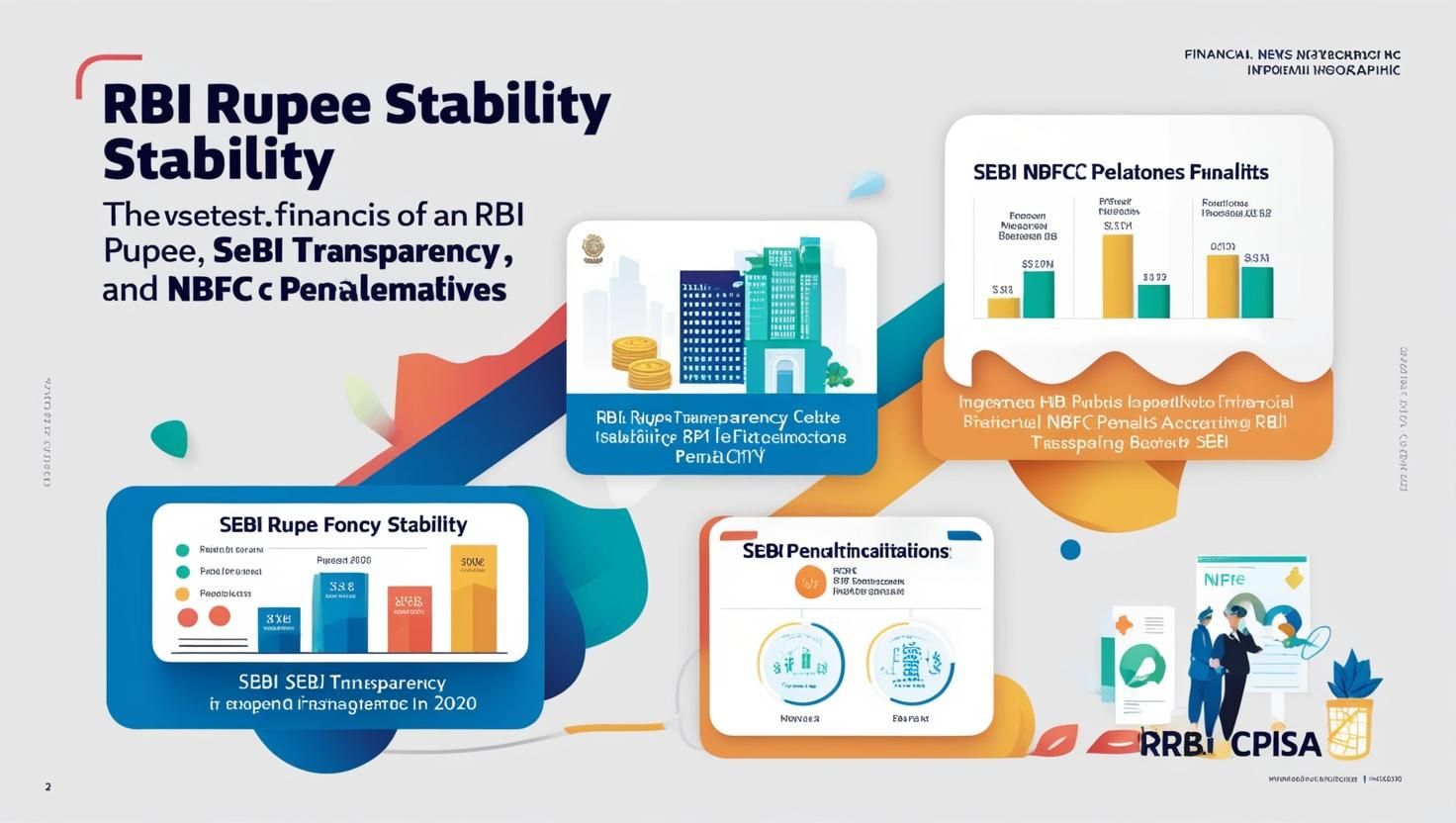RBI Rupee Stability & SEBI’s Transparency Push: Govt and Market Reforms
RBI Rupee Stability: Govt and Central Bank’s Plan to Defend Currency Amid Volatility

RBI Rupee Stability, SEBI Transparency & NBFC Penalties: Latest Financial Reforms
RBI Rupee Stability remains a priority as the Reserve Bank of India (RBI) actively intervenes in the forex market to manage rupee depreciation and mitigate volatility. Meanwhile, SEBI’s new chairman, Tuhin Kanta Pandey, has pledged greater transparency in regulatory governance. Additionally, RBI has imposed penalties on four NBFCs for compliance violations related to peer-to-peer lending platforms.
This blog explores RBI’s rupee defense strategies, SEBI’s latest transparency push, and recent penalties imposed on NBFCs.
Table of Contents
- RBI’s Currency Defence: Govt’s Stance on Rupee Stability
- SEBI’s Push for Transparency and Conflict Disclosures
- RBI Fines NBFCs for Compliance Violations
- Rupee Depreciation Trends: A Market Overview
- Conclusion: What Lies Ahead for RBI and SEBI?
RBI’s Currency Defence: Govt’s Stance on Rupee Stability
The Reserve Bank of India (RBI) and the Indian government have reinforced their commitment to RBI Rupee Stability, actively managing currency fluctuations to safeguard the economy. The rupee’s depreciation in recent months has prompted strategic interventions aimed at preventing excessive volatility, ensuring a balanced foreign exchange market.
Government’s Position:
- The government views rupee stability as critical to economic resilience, particularly in trade and investment flows.
- Senior officials emphasize that India’s forex reserves of $638.7 billion (as of February 2025) provide a strong buffer against speculative pressures.
- The government expects RBI’s interventions to restore the rupee to December 2024 levels, which averaged ₹84.99 per USD.
- With a volatile global market, policymakers are prioritizing a gradual and controlled currency movement rather than abrupt fluctuations.
RBI’s Strategic Interventions:
- Active Forex Market Participation: RBI has been actively buying and selling dollars to prevent extreme currency fluctuations.
- Monitoring Foreign Exchange Reserves: RBI ensures that interventions do not deplete reserves excessively, balancing defense strategies with macroeconomic stability.
- Interest Rate and Liquidity Adjustments: RBI leverages interest rate policies and liquidity management tools to moderate rupee depreciation without harming economic growth.
- Targeted Market Signals: The central bank provides guidance to currency traders and financial institutions to instill confidence in forex markets.
Impact on Trade and Investment:




Challenges & Future Outlook:
- Geopolitical Uncertainty: Global economic slowdowns and US tariff policies could continue to pressure the rupee.
- Capital Outflows: Persistent foreign portfolio investor (FPI) withdrawals may exert downward pressure on the currency.
- US Federal Reserve Policy Impact: Tightening monetary policies in the US could lead to a stronger dollar, making RBI’s stabilization efforts more challenging.
- Long-Term Policy Adjustments: The government and RBI may explore structural reforms, including trade diversification and financial sector improvements, to enhance rupee stability in the long run.

The Indian government has taken a proactive stance to ensure RBI Rupee Stability, emphasizing that excessive depreciation of the rupee is not desirable. The government has been in continuous discussions with the Reserve Bank of India (RBI) to monitor currency fluctuations and devise interventions that can mitigate volatility while allowing market-driven adjustments.

- The government remains firmly against excessive rupee depreciation, emphasizing a stable exchange rate for trade, investments, and macroeconomic stability.
- Authorities believe that India’s forex reserves of $638.7 billion (as of February 2025) are sufficient to defend the rupee against aggressive declines.
- Senior officials expect RBI to restore the rupee to December 2024 levels, averaging ₹84.99 per USD.

- RBI remains committed to curbing excessive forex volatility.
- Despite speculation, RBI has not changed its forex policy, even under the new governor.
- Strategic interventions aim to stabilize the rupee without disrupting market forces.
SEBI’s Push for Transparency and Conflict Disclosures

- SEBI’s new chief, Tuhin Kanta Pandey, aims to improve transparency and accountability in regulatory functions.
- SEBI will disclose board conflicts of interest to enhance investor confidence.

- Calls for transparency follow allegations of conflicts of interest during Madhabi Puri Buch’s tenure.
- SEBI’s board meetings and decisions remain largely undisclosed, raising concerns about impartiality.

- Foreign investors have withdrawn $27 billion since September 2024, impacting market sentiment.
- SEBI plans to engage with FPIs and AIFs to ease compliance burdens and attract long-term capital.

- More transparent regulations may restore investor trust.
- Improved disclosure norms align SEBI with global best practices.
RBI Fines NBFCs for Compliance Violations
Penalty Details:
- RBI has imposed a total penalty of ₹76.6 lakh on four NBFCs for non-compliance with peer-to-peer lending platform regulations.
- Breakdown of penalties:
- ₹40 lakh on Fairassets Technologies India
- ₹10 lakh each on Bridge Fintech Solutions & Rang De P2P Financial Services
- ₹16.6 lakh on Visionary Financepeer

- Violations pertain to the ‘Non-Banking Financial Company – Peer-to-Peer Lending Platform (Reserve Bank) Directions, 2017’.
- RBI clarified that the penalties were due to deficiencies in regulatory compliance, not the validity of transactions between entities and customers.
- Each penalty was communicated separately by RBI.

- NBFCs need to ensure compliance with RBI’s lending regulations to avoid penalties.
- RBI’s enforcement reinforces its commitment to financial system integrity.
Rupee Depreciation Trends: A Market Overview
The Indian rupee has been on a declining trend, reflecting both domestic and global economic conditions.

- The rupee weakened 3.5% against the dollar in the past six months, reaching 86.88 on March 7, 2025.
- Comparatively, the Chinese Yuan and Japanese Yen weakened 1.7% and 0.7%, respectively.

- The IMF recently reclassified India’s exchange rate system from floating to a stabilized arrangement.
- RBI’s past interventions have contributed to stability, but external pressures remain.

- Depreciation attracts forex market participants.
- Foreign investment movements continue to influence currency volatility.
Conclusion: What Lies Ahead for RBI and SEBI?





Disclaimer—Estabizz Fintech Private Limited
At Estabizz Fintech Private Limited, we strive to provide accurate financial insights. However, this blog is for informational purposes only and does not constitute investment, legal, or financial advice.
Readers should consult financial professionals before making any investment or forex trading decisions. Market conditions are subject to change, and RBI & SEBI policies should be monitored for updates.
For custom financial solutions and expert guidance, reach out to us today!








